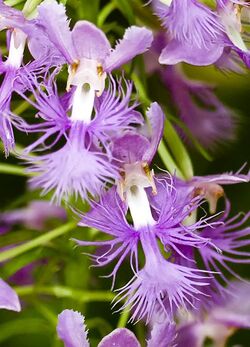Biology:Platanthera shriveri
| Shriver's purple fringed orchid | |
|---|---|

| |
| Platanthera shriveri | |
| Scientific classification | |
| Kingdom: | Plantae |
| Clade: | Tracheophytes |
| Clade: | Angiosperms |
| Clade: | Monocots |
| Order: | Asparagales |
| Family: | Orchidaceae |
| Subfamily: | Orchidoideae |
| Genus: | Platanthera |
| Species: | P. shriveri
|
| Binomial name | |
| Platanthera shriveri P.M.Br.
| |
Platanthera shriveri, Shriver's purple fringed orchid,[1] is a rare orchid endemic to the United States. It is considered critically imperiled.[2]
Description
Platanthera shriveri plants look very similar to Platanthera grandiflora and a hybrid origin with Platanthera lacera is suspected. To distinguish Platanthera shriveri from Platanthera grandiflora small morphological details and a different bloom time (July and August, about 3 weeks later) have to be observed.[1]
Distribution and habitat
The only known populations are in Maryland, North Carolina, Pennsylvania (historic record only), Virginia and West Virginia.[2] They grow in woodlands and along stream banks.
Taxonomy
Platanthera shriveri was described as a new species by P. M. Brown in 2008.
There is ongoing research whether the plants described as Platanthera shriveri are a separate botanical species or can be considered within the morphological and bloom time ranges of Platanthera grandiflora.[3]
References
- ↑ 1.0 1.1 "Platanthera shriveri". North American Orchid Conservation Center (NAOOC), Smithsonian Environmental Research Center. 2018. http://goorchids.northamericanorchidcenter.org/species/platanthera/shriveri.
- ↑ 2.0 2.1 "Platanthera shriveri". NatureServe, Arlington, Virginia. https://explorer.natureserve.org/Taxon/ELEMENT_GLOBAL.2.821738/Platanthera_shriveri.
- ↑ Pace, Matthew C. (2020). "The Orchidaceae of northeastern North America". Memoirs of the Torrey Botanical Society (Torrey Botanical Society) 29: 156–189.
Wikidata ☰ Q15437363 entry
 |

